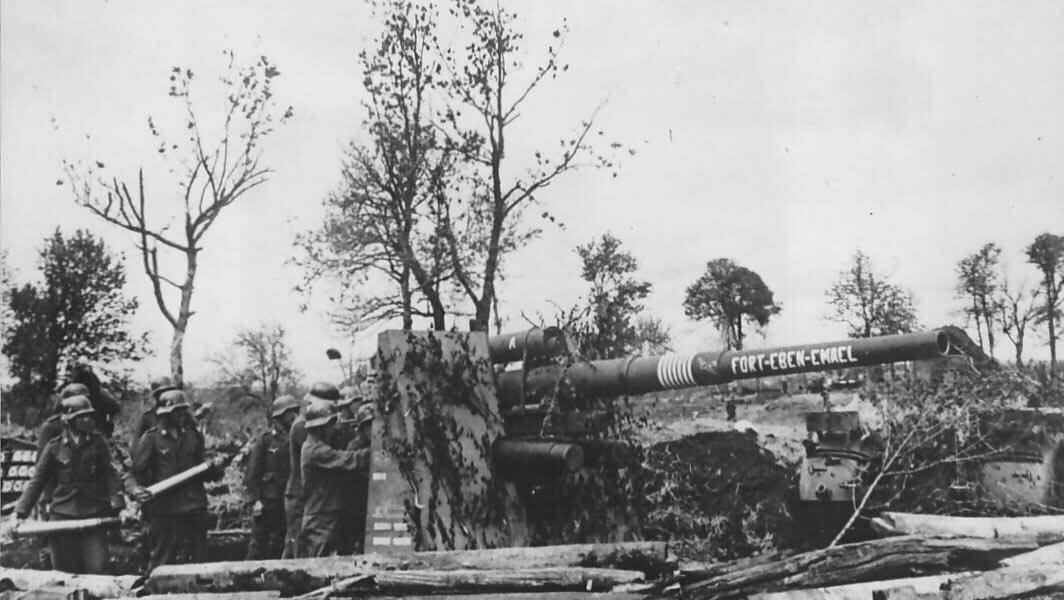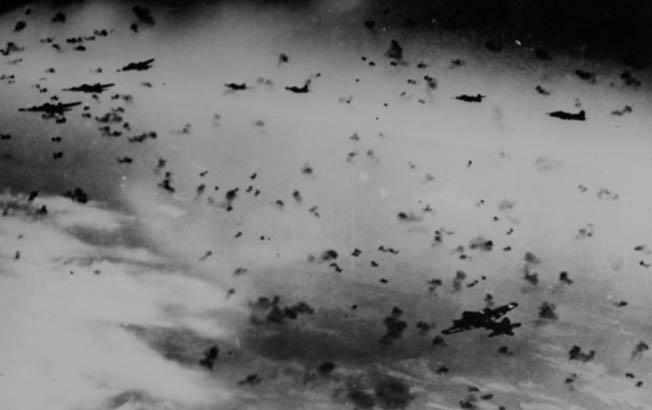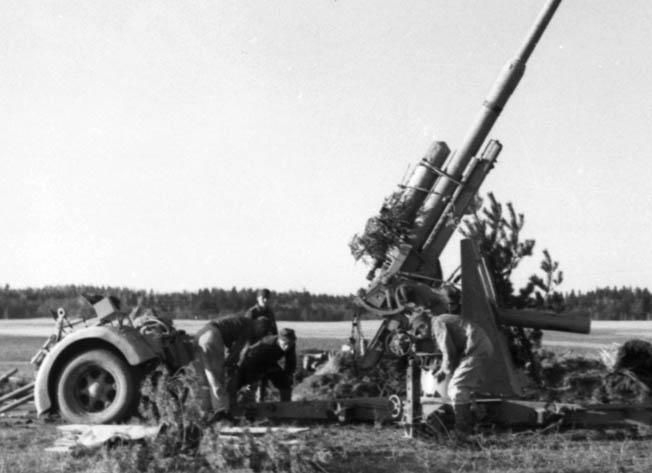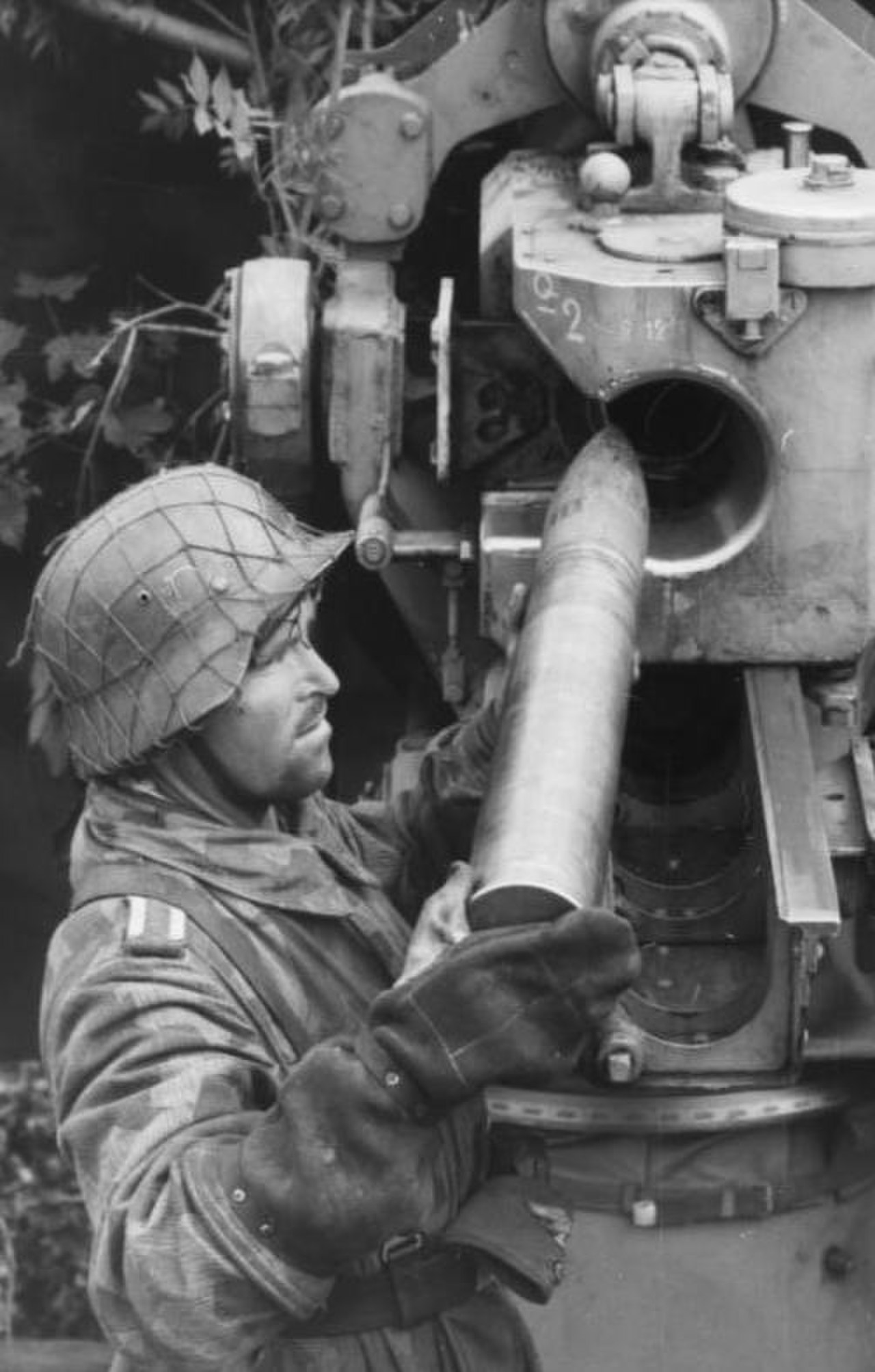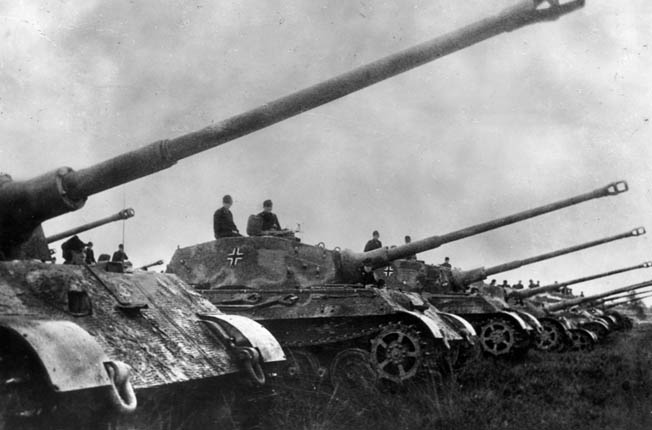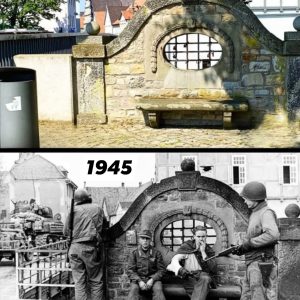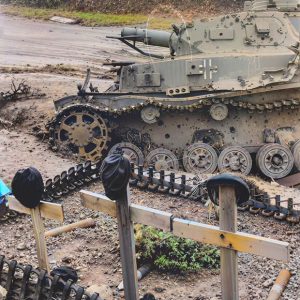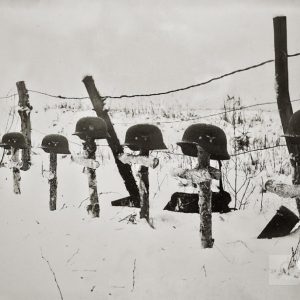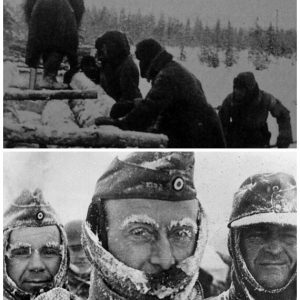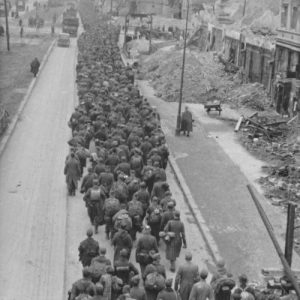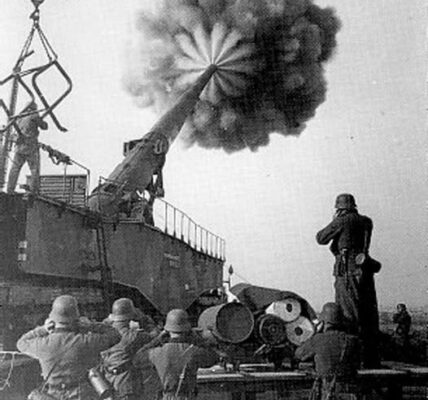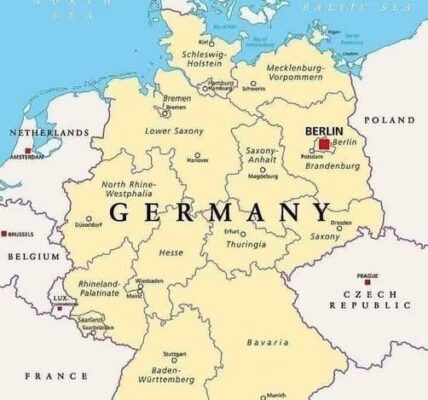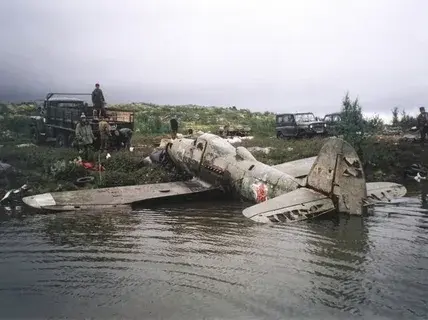

The German 88 mm gun, originally designed as an anti-aircraft artillery weapon, was equally effective as an anti-tank gun.
The daytime flight of Teddy’s Rough Riders on November 21, 1944, was anything but routine for American pilot Werner G. Göring, nephew of Nazi Reich Air Minister Hermann Göring [ Editor’s note: see below for a reader’s comment on Werner Göring ], and the other nine men aboard the ill-fated B-17 Flying Fortress. Earlier that same day, the aircraft had flown about four hours east in an armada of 1,291 bombers to attack Leuna, a major chemical complex deep in the heartland of Germany. The aircraft was nearly fatally damaged by heavy anti-aircraft fire from a German 88mm anti-aircraft gun (FlaK) and other anti-aircraft guns. On the way back to safety in England, its two port engines began smoking and had to be shut down. The two remaining engines had to be revved as far as possible to keep the Fortress airborne.
Fuel was running low when Göring ordered his crew to hold still during a low-level flight over the icy English Channel. As they approached Molesworth Air Base, the heavy Fortress was significantly underpowered and occasionally entered a spin. The aircraft vibrated violently in the air but eventually skidded to a stop after circling over a grassy strip next to the main runway. The crew had returned safely from another flight over Germany despite extensive damage, including more than 245 holes, largely caused by the intense ground fire over Leuna.
25 lost, 567 damaged. But how?
Others were less fortunate. 25 of the 1,291 bombers that took off that morning never returned, and another 567 were damaged, mostly by anti-aircraft fire. The Luftwaffe was a shadow of its former self at this point in the war, but the German defenses—bolstered by the 88s and larger guns—destroyed 6,400 Anglo-American aircraft and damaged 27,000 more in 1944 alone.
The 88 was considered the best gun of the war. It was rightly feared by Allied pilots, tank drivers, and infantry due to its precision, lethality, and versatility. The weapon was used on German tanks, as an anti-tank gun, assault gun, and for anti-aircraft defense.
One infantryman aptly described the weapon as “anti-everything.” During the war, it even reluctantly made its way into American comics. Cartoonist Bill Maudlin depicts GI Willie angrily telling an officer, “I’ll let you know when we catch the inventor of the 88.”
The origins of the German 88 mm cannon
The history of the German 88 mm cannon dates back to 1916, when the German Army first adapted the proven German naval weapon for ground warfare during World War I. Machinery for manufacturing barrels and ammunition was readily available at the Krupp AG and Rheinmetall production facilities. The German Navy adopted the cannon primarily because an 88 mm cartridge was considered the largest and heaviest (approximately 15 kg) that a single man could handle.
The World War I model could fire a 9.6-kilogram explosive to an altitude of 6,850 meters, with a maximum range of 10,800 meters. Even then, the Germans relied on simple trailers, stabilized by folding boom arms on both sides and pulled by tractors, to give the guns a high degree of mobility. By the end of 1918, the Germans had even implemented rudimentary forms of central fire control for the weapon. (Take a detailed look at World War I and all the moments that shaped our history in Military Heritage magazine .)
At the end of World War I, the Treaty of Versailles imposed severe sanctions on the German military-industrial complex, particularly on Krupp and Rheinmetall. Both companies established relationships with foreign companies, enabling research and development away from the watchful Versailles inspectors. By 1933, the first examples of the updated 88 were in the hands of the Wehrmacht. Serial production of the weapon, officially designated the 88 mm FlaK 18, began in early 1936. The 18 was used in the name to deceive treaty observers into believing it was merely a copy of the 1918 model.
Design improvements (and significant setbacks) in the 1930s
Indeed, the modernized weapon represented a dramatic advance. Originally designed to shoot down bombers, it was semi-automatic. The weapon’s recoil was used to eject the spent cartridge case and cock the firing mechanism. The next round could be loaded by hand or with a power-assisted rammer. The highly maneuverable axle-mounted undercarriages could lower the cruciform firing platform for a more stable shot. The barrel could be swiveled a full 360 degrees, and a trained gun crew could fire over 20 rounds per minute.
The FlaK 18 had a one-piece barrel with an expected service life of 900 rounds. It was equipped with cordite propellant and projectiles with copper drive bands. This short barrel service life necessitated barrel replacement in the field. Rheinmetall developed a three-piece barrel solution that allowed field technicians to replace only the center section, which was subject to the most severe fire. By using the small sections of the inner barrel, serious problems during maintenance, repair, and field supply were avoided.
The introduction of the three-piece barrel, known as the RA 9, brought with it further unforeseen difficulties. For example, expensive and rare steel had to be used, as the new barrel lacked the rigidity of the previous one-piece design. Tighter manufacturing tolerances were also required, requiring additional man-hours in design. The heavier barrel also led to modifications to the carriage components of the recoil and counterbalancing mechanism. Finally, a two-piece inner barrel was introduced to reduce wear and the risk of case jamming.
The use of the RA 9 and its modified carriage led to the development of the 88 mm FlaK 36. As the war progressed, the use of propellants such as diglycol and Gudol reduced barrel wear. The later replacement of copper bands with sintered iron bands also reduced wear compared to the more expensive and difficult-to-obtain copper bands. These developments increased barrel life to 6,000—in some cases 10,000—rounds, eliminating the original reason for the multiple barrels. However, German production lines were not so easily adaptable, so the Nazis continued to produce the expensive and time-consuming multiple barrels until a factory in Pilsen succeeded in producing a monoblock barrel using a novel vertical centrifuge casting process during the last year of the war.
A case of “The Clanks”
The modernized German 88 mm FlaK 37s featured a fire control data display that was sophisticated for the time. This anti-aircraft gun was originally intended for homeland defense, although 90 FlaK 37s were sold to Finland for defense against Soviet air raids. Nearly 200 of these guns fell into Norwegian hands after the German withdrawal.
All three models of the early 88s were 56 calibers long, meaning the barrel length was 56 times that of the 88mm caliber. The standard gun fired a 17-pound fragmentation shell that could rise thousands of feet in the air and then burst into 1,500 or more fragments, capable of damaging or destroying any aircraft within 200 meters.
The anti-aircraft shells had two types of fuses: those with barometric fuses set at specific altitudes, and those with time fuses. Regardless of the cause, the sharp steel fragments could easily decapitate or dismember one or more crew members. The consequences of such an attack could be devastating, even for the survivors. Many suffered from the “clang,” a paralyzing sense of fear, and became known as “dead men in flight.”
In the first half of 1944, for every 1,000 bomber crews deployed for six months, there were 712 killed or missing and 175 wounded—a rate of 89 percent. Barely a quarter of US pilots completed 25 missions over Germany. After the liberation of France and Belgium, this minimum quota was increased to 30, and then to 35.
For anti-aircraft use, the FlaK 18 and 36 guns had a fuze setting device on the left side, while the FlaK 37 had a slightly different device. The tip of the projectile was inserted into a tray on top of the machine, which automatically set the fuze based on the target data transmission. Once set, the projectile was pushed out of the device for loading. Later in the war, some FlaK 37 guns had the fuze setting device located on the loading tray, which sped up the process. If necessary, time fuses could be manually set by a member of the gun’s eleven-man crew using a special key.
Deadly effective “AP” cartridges
Specifications for the German 88 mm gun vary slightly for the first three models, depending on the model and crew training. It could fire 15 to 20 rounds per minute and could be ready for action within 2.5 minutes, even with a reduced six-man crew. The same small crew could make the gun ready for action within 3.5 minutes. The maximum range was 14,860 meters, and the maximum vertical range was stated as 10,600 meters.
As the weapon’s capabilities expanded, so did the types of ammunition used by the Nazis. A German ammunition list from 1944 lists 19 different types of ammunition. These included eight types of high-explosive (HE) and seven armor-piercing (AP) shells, with the remainder being kinetic solid-fuel projectiles. The HE shells had two types of fuzes. For anti-aircraft defense, clockwork time fuses were used. Towards the end of the war, the time fuse mechanism was supplemented with a percussion element. Both types of fuzes were used to engage ground targets, with the clockwork mechanism capable of triggering deadly air explosions over Allied positions.
The AP grenades also proved deadly. Once the projectile penetrated the target, a small explosive charge was detonated by a delayed impact fuse with a tracer in the base. The tracer assisted the gunner, and the delayed fuse contributed to the destruction of the target. Not entirely satisfied with this, the Germans produced the AP40 grenades for use in anti-tank and tank guns. These used tungsten carbide penetrator rounds without an explosive charge, which contained more energy relative to their weight and size. Fortunately for the Allies, the use of the AP40 grenades was limited by the limited supplies of tungsten carbide.
The basic AP grenade used chemical rather than kinetic energy. It utilized the shaped charge principle to penetrate armor with an extremely hot jet that burned into the target. Most of these grenades were used primarily in the fearsome Tiger I tank.
Mounting the 88 on the First Tigers
The Germans developed the Sd Kfz 7, a half-track vehicle, to transport the 88s on their Sonderanhanger 201 trailers. This specially designed vehicle was essentially an artillery tractor with tracks on the rear axle and conventional tires on the front steering axle. The tracks enabled off-road capability and contributed significantly to the 88’s usefulness, especially on the poor roads of the Eastern Front, which were often little more than muddy tracks.
The Germans were so impressed with the 88 that as early as 1936, plans were underway to mount the weapon on a tank that eventually became the Tiger I.
While the ballistics of the German 88 mm KwK 36 tank gun and the anti-aircraft gun were identical, the tank gun had a one-piece barrel and a thin jacket. Like other German tank guns, the breechblock was shifted vertically, instead of the horizontal sliding block of the anti-aircraft guns. The recoil mechanism was different, and there was a muzzle brake with a double flap to reduce the load on the vehicle.
The tank’s trigger was moved from the breechblock to the gunner’s raised handwheel. The heavy and well-armored turret moved slowly, further reinforcing the tank’s reputation for being cumbersome. The ammunition was equivalent to that of the FlaK 18-37 anti-aircraft guns, except for the electric primers, which were powered by a 12-volt vehicle battery. Approximately 92 rounds could be carried in and under the turret, and crews often managed to store additional ammunition.
The accuracy and range of the Tiger I’s 88mm cannon often gave the Germans a “one shot, one kill” ratio compared to Allied tanks and their crews.
The size and weight of the 63-ton Tiger, along with its somewhat underpowered 700-horsepower V-12 Mayback engine, hampered its mobility and usefulness on the battlefield, despite its formidable cannon.
A self-propelled weapon with 360-degree maneuverability
The Germans also used the 88 mm gun as a self-propelled gun. This further improved its mobility and increased its usefulness for close support of ground troops. The result was the self-propelled gun with armor to protect the engine and driver. Six of these tank destroyers were successfully used in the Battle of France. However, the vehicle proved to be nose-heavy and offered very little room for the crew to operate the gun. The gun’s freedom of movement was restricted, there was little space to carry ammunition, and no provisions for outriggers to stabilize the gun during firing. These vehicles were followed by the Zugkraftwagen 18t, a larger, more powerful, and more heavily armored vehicle capable of traveling at 40 kilometers per hour. This vehicle’s gun could be elevated and rotated 360 degrees for anti-aircraft use. It featured outrigger legs and a more comfortable firing platform for the crew.
Originally, 112 units were planned, but by June 1943, only 14 had been produced. Production was halted as other programs took priority. As Germany’s military prospects continued to bleak, more prototypes were built, including one on a converted bus chassis. The few units actually produced were rushed to the Eastern Front to slow the Red Army’s advance.
The 88 was also mounted on railway wagons and used for anti-aircraft defense. In some cases, entire railway batteries were stationed in train stations. The Germans also mounted the guns on the Siebelfähre, a shallow-draft, double-hulled vessel. These floating gun platform-ferry combinations proved extremely effective and were used in the successful evacuation of two German divisions and their equipment from Sicily.
The 88 on the Tiger II
Further development of the basic FlaK gun led to the development of the 88 FlaK 41, which first entered service in Tunisia at the end of 1943. The barrel was lengthened to the point where it consisted of five main components. The multi-section barrel initially presented similar difficulties to previous multiple barrels. Despite its complexity and high production costs, the gun represented a significant improvement over earlier models. The number of barrel segments was initially reduced to four and then to three to avoid jamming. The maximum range of the gun was 19,800 meters (from a distance of 10,600 meters).
The German 88 mm FlaK 41 used an 858 mm long cartridge, significantly longer than its predecessors. The FlaK 41 was used primarily for air defense in the West, so its use for anti-tank defense was limited. The Germans found it outperformed the older but larger heavy 10.5 cm FlaK 38 and 39 anti-aircraft guns.
The Germans also developed the 88 PaK 43 as a dedicated anti-tank weapon, the first examples of which rolled off the production line in late 1943. It soon became known as perhaps the best all-round anti-tank gun of the war. It could easily deliver 360 degrees of firepower and penetrate the frontal armor of any Allied tank on the battlefield. The gun’s distinctive, steeply sloped frontal armor could deflect most incoming projectiles. The barrel consisted of two segments, and the breech was semi-automatic. The gun’s maximum range was 15,150 meters, allowing it to be used as a support field gun in addition to its anti-tank function.
The 88 PaK 43 was modified and mounted on the Tiger II. This fearsome tank was designed to fire 40 HE and 40 AP shells and first saw service on the Eastern Front in early 1944. The Tiger II weighed almost 69 tons—significantly more than its predecessor—but was still powered by the same Mayback engine. This caused concern among the German army, as the Tiger II lacked speed, maneuverability, and exceptional fuel efficiency. Due to these limitations, it was used primarily in defensive roles toward the end of the war.
From anti-aircraft to anti-tank
The PaK 43 was also used as a self-propelled gun in various versions, including the Nashorn and Ferdinand. The latter entered service in 1943 during the Battle of Kursk, where 89 units were reportedly used. Despite initial design flaws, the Ferdinands reportedly destroyed around 200 Soviet tanks. The survivors of the fierce fighting around Kursk were extensively rebuilt and renamed Elefant.
The PaK 43 was also installed on the Panzerjäger Panther—or Jagdpanther—a fast anti-tank gun launcher. It weighed 46 tons, could carry up to 60 rounds, and reached a speed of 48 kilometers per hour. Although fewer than the 425 units produced were actually delivered, the Jagdpanther saw service on all fronts and earned the grudging respect of the Allies.
Interestingly, both Great Britain and the United States possessed guns with similar anti-aircraft capabilities to the 88 FlaK. Both the British 94 mm and American 90 mm cannons could fire higher and carry larger projectiles. On paper, many claim, they were superior to the German gun. However, both weapons were bulkier and heavier. The Allies limited these guns to their original anti-aircraft role, while the Germans expanded the 88’s role to include anti-tank defense and use against fortified ground positions. This, in turn, led to further advances in rammers, fuzes, and improved ammunition handling systems—all of which made the weapon far more versatile and effective.
The Germans’ flexible and innovative approach to developing the first 88 FlaK allowed them to learn and adapt as the war progressed. This allowed them to improve the weapon’s anti-aircraft capabilities and successfully convert it for anti-tank, anti-tank, and similar ground roles. This contributed significantly to the 88’s enduring reputation as a legendary large gun of World War II.
